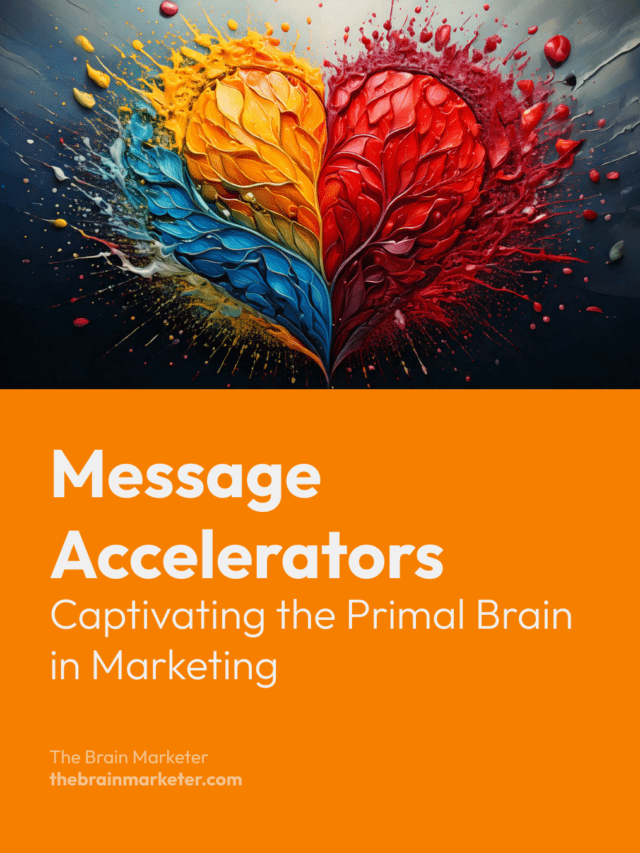In marketing, capturing and sustaining attention is only half the battle. The real challenge lies in the message accelerators, delivering it in a way that resonates instantly with the primal brain and drives immediate responses. From direct language to emotional triggers and visual credibility cues, these strategies can shape how consumers react.
Let’s break down the core message accelerators that influence instinctive decision-making.
Key Takeaways
- The primal brain responds to personal, emotional, and visual messages.
- Use “you” language to trigger self-relevance.
- Colors, tone and authenticity build credibility instantly.
- Contrast and mini-dramas make the message stick.
- Leverage the three learning channels (visual, auditory, kinesthetic) for deeper retention.
- Simplicity is essential, complexity repels the primal brain.
🎙️ Unpack the Topic with this Podcast
1. The Power of “You”
The primal brain is self-centered. Using the word “you” speaks directly to this instinct, making the message feel personal and relevant.
It’s not about the product, it’s about how it benefits the consumer.
Example:
✅ “By purchasing this Renault, you will save 50% on energy costs while driving.”
❌ “The new electric car from Renault saves 50% on energy.”
2. Establishing Credibility (and the Role of Color)
The primal brain rapidly evaluates trust. Subtle cues (tone of voice, facial expressions, body language) help us decide whether to trust a person or brand. Neuroscientist Joseph LeDoux has shown that our brains can detect dishonesty before we’re even consciously aware of it.
Visual Cues and Color Psychology
Color impacts emotional response faster than words. When chosen wisely, it reinforces a brand’s credibility and positioning.
| Color | Symbol | Used By |
|---|---|---|
| Red | Power, Activity, Confidence | Coca-Cola, Red Cross |
| Pink | Calm, Femininity | Barbie, Pepto Bismol |
| Orange | Movement, Energy, Construction | Home Depot, Cingular Wireless |
| Yellow | Lightness, Future, Philosophy | Kodak, National Geographic |
| Green | Money, Growth, Environment | Starbucks, BP |
| Blue | Trust, Authority, Security | IBM, Microsoft, American Express |
| Purple | Royalty, Spirituality, New Age | Yahoo!, Sun Microsystems |
Example: Blue is often used by tech and finance companies to convey security and authority. Red signals confidence and action.
3. Emotional Contagion: Passion and Honesty
Emotion spreads. When delivered with genuine passion, your message triggers mirror neurons in the primal brain, making the audience feel what you feel.
“Passionate people see no obstacles, only opportunities.” — Patrick Renvoisé (2005)
But emotion must be authentic. The primal brain rejects anything that feels fake. Admitting uncertainty can build more trust than pretending to have all the answers.
Example: “I don’t know, but I’ll find out.” > “Let me give you a confident but false answer.”
4. Similarity and Accessibility
We are naturally drawn to people and brands that reflect who we are. Shared values, language or background build instant affinity.
Tip: Highlight shared experiences, beliefs or challenges. The more your audience feels understood, the more persuasive your message becomes.
5. The Power of Contrast
Without contrast, there’s no urgency. The primal brain needs to feel a difference between pain and relief, risk and reward.
“If you’re selling fire extinguishers, start by lighting a fire.” — David Ogilvy
Showcase the before and after. Make your offer stand out by showing how it solves something others don’t.
6. Emotional Storytelling: The Mini-Drama
Mini-dramas recreate the emotional journey:
- Frustration — the problem before your product.
- Transformation — the moment of change.
- Relief — the emotional payoff.
This structure engages both memory and emotion: essential tools of the primal brain.
7. The Three Learning Channels
Your audience absorbs information in different ways. Use all three:
| Learning Style | Content Format |
| Visual | Photos, videos, charts |
| Auditory | Podcasts, voiceovers, written text |
| Kinesthetic | Demos, hands-on actions, interactive UX |
8. Simplicity: The Ultimate Accelerator
The primal brain avoids complex information. Clarity wins attention and trust.
Tip: Focus on one or two core frustrations your solution solves. Say less. Say it better.
Conclusion: Accelerate the Brain, Accelerate the Action
Marketing that connects with the primal brain drives immediate action. When your message is:
- Clear
- Emotionally charged
- Visually credible
- Personally relevant
…it travels faster and sticks longer.
Use message accelerators to accelerate your message. Influence instinct. And always keep it simple.
Sources
- LeDoux, J. E. (1996). The Emotional Brain: The Mysterious Underpinnings of Emotional Life. Simon & Schuster.
- Renvoisé, P., & Morin, C. (2005). Neuromarketing: Understanding the Buy Buttons in Your Customer’s Brain. Thomas Nelson.
- Ogilvy, D. (1983). Ogilvy on Advertising. Crown Publishing Group.
- Color associations adapted from brand identity strategies by SalesBrain and traditional color psychology.

Vincent Heimann is a marketing project manager and neuromarketing enthusiast. He founded The Brain Marketer to bridge neuroscience and marketing through accessible, science-based content. With over 10 years of experience in digital strategy, UX/UI and communication, he shares practical insights to help brands connect with the human brain — ethically and effectively

